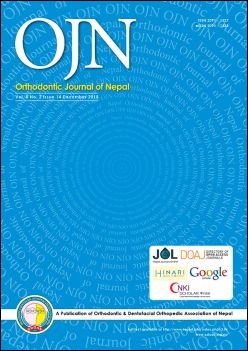Variation of Facial Soft Tissue Thickness in Nepalese Adult Orthodontic Subjects
DOI:
https://doi.org/10.3126/ojn.v8i2.23067Keywords:
Facial soft tissue thickness, Nepalese adult population, Sagittal skeletal malocclusionAbstract
Introduction: Variations in facial soft tissue thickness have been established previously by studies conducted in different population. Hence, it is essential to obtain facial soft tissue thickness measurement data specific to a population and develop individual standards. The objective of this research is to obtain facial soft tissue thickness data of Nepalese adult male and female subjects seeking orthodontic treatment with different sagittal skeletal malocclusion and evaluate variations in facial soft tissue thickness.
Materials & Method: Facial soft tissue thicknesses was measured manually on ninety pretreatment lateral cephalogram at eleven points (Glabella, Nasion, Rhinion, Subnasale, Labrale superius, Stomion, Labrale inferius, Labiomentale, Pogonion,Gnathion and Menton). One-way Analysis of variances [one-way ANOVA] followed by Least significant difference (LSD) post hoc test was used to determine difference in facial soft tissue thickness measurements among three sagittal skeletal group for both sexes. In addition, Student’s t-test was used to find difference in facial soft tissue thickness between the male and female subjects in each skeletal Class.
Result: Statistically significant differences were found at points Rhinion, Subnasale, Labrale superius, Stomion and Gnathion in males and at Subnasale, Labrale superius, Stomion and Labrale inferius in females while comparing facial soft tissue thickness among three sagittal skeletal classes. Also, it was observed that mean facial soft tissue thickness was greater for males as compared to female subjects with significant differences at Subnasale, Labrale superius, and Labrale inferius in each skeletal Class.
Conclusion: Facial soft tissue thickness varies considerably among different population group, sex and sagittal relationship of jaws.
Downloads
Downloads
Published
How to Cite
Issue
Section
License
Copyright © held by Orthodontic & Dentofacial Orthopedic Association of Nepal
- Copyright on any research article is transferred in full to the Orthodontic & Dentofacial Orthopedic Association of Nepal upon publication in the journal. The copyright transfer includes the right to reproduce and distribute the article in any form of reproduction (printing, electronic media or any other form).
- Articles in the Orthodontic Journal of Nepal are Open Access articles published under the Creative Commons CC BY License (https://creativecommons.org/licenses/by/4.0/)
- This license permits use, distribution and reproduction in any medium, provided the original work is properly cited.




